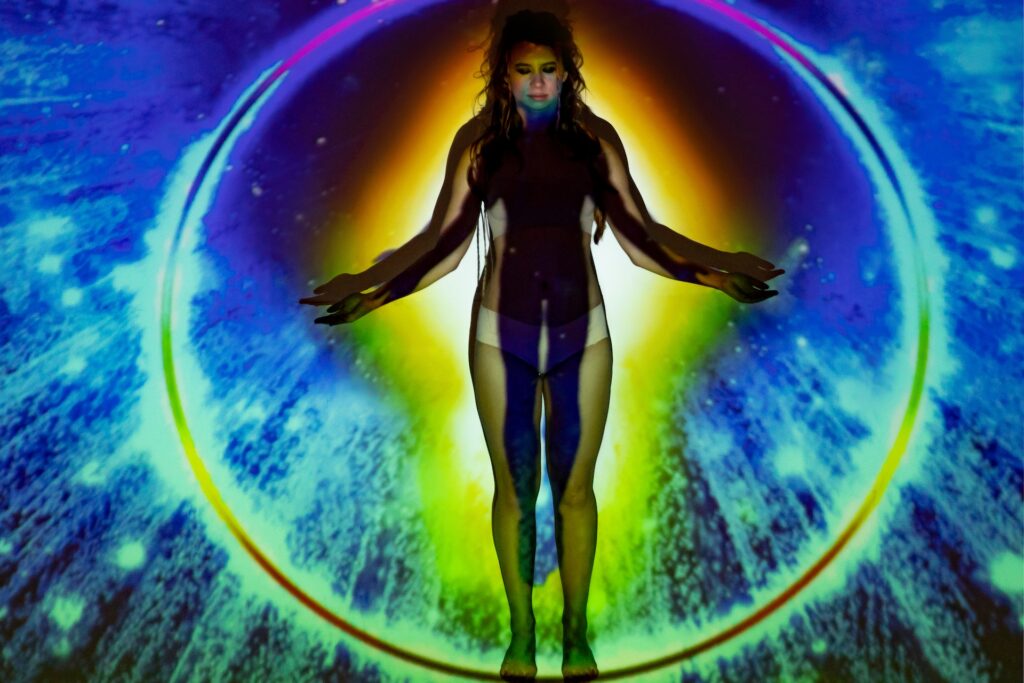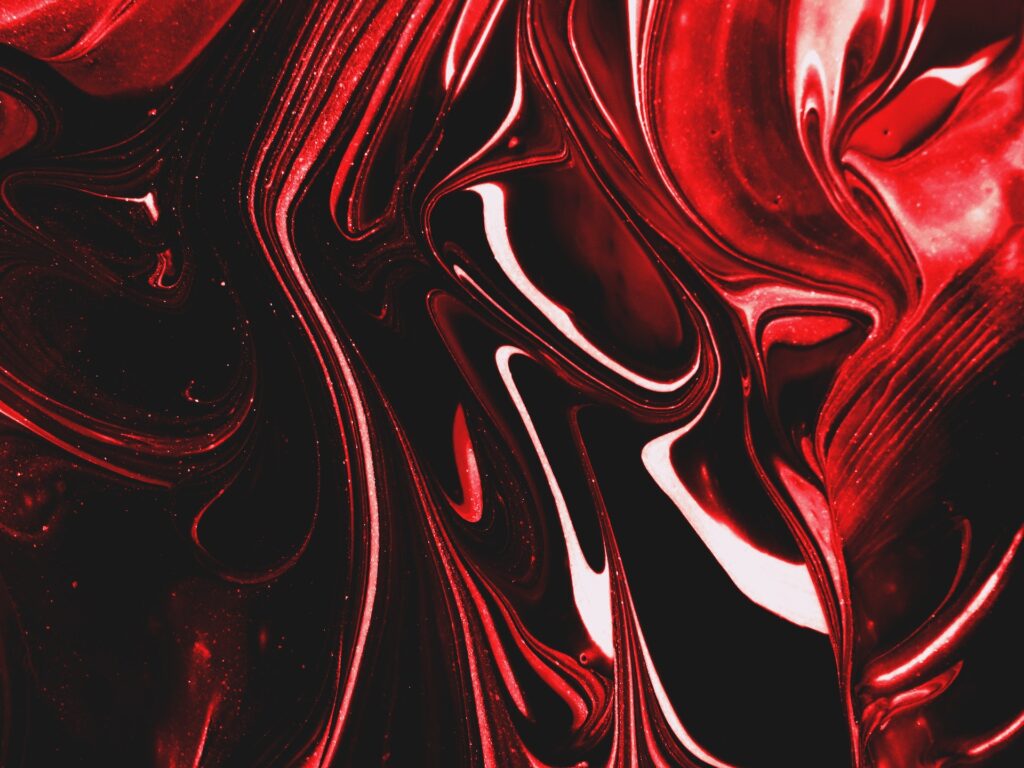
Every individual possesses the capacity to tap into their energy focal points, unlocking their internal potential and materializing their greatest aspirations. The seven distinct chakra energy centers in yoga correspond to specific hues, each representing various facets of our physical, emotional, and spiritual welfare. From the foundational vigor of the root chakra in crimson to the perceptive sagacity of the crown chakra in violet, acquainting oneself with these seven chakra shades offers a swift and uncomplicated method to fortify, harmonize, coordinate, and unveil these enigmatic and delicate energies, fostering enhanced vitality, spiritual communion, and overall well-being.
What Constitutes the Chakra Color Spectrum?
A set of seven primary chakras is linked with individual colors, forming the spectrum of chakra hues: red, orange, yellow, green, blue, indigo, and violet. Recalling this arrangement is simplified by the acronym ROYGBIV.
Comprehending the significance and symbolic connotations of these hues is pivotal for those on a quest to stabilize and rejuvenate their chakras, as well as for comprehending the situation and role of each energy center. Refer to the chakra color chart below for a concise overview of the colors and the implications associated with each focal point.
Why are chakras assigned specific colors?
The rationale behind the distinct colors attributed to the seven chakra centers stems from their connection to individual energy frequencies. When the chakras operate optimally, energy moves unrestricted, resulting in vivid and clear colors associated with each. Conversely, imbalances or blockages disrupt the energy flow, leading to dull or faded colors. These colors are believed to aid in aligning and harmonizing the chakras, fostering physical, emotional, and spiritual health. Grasping the significance and symbolism of each chakra’s color can assist individuals in identifying energy imbalances and progressing toward restoring equilibrium.
What is the origin of chakra colors?
The foundation of the yogic energy center system traces back to the Kubjikamata-Tantra, an 11th-century text on tantra yoga. Further elaboration on this system is found in the Sat-Chakra-Nirupana, which was translated into English by Sir John Woodroffe in his 1919 publication, “The Serpent Power.” While Woodroffe introduces colors in explaining the symbolism of these rotating energy wheels, the color associations were introduced by Charles W. Leadbeater in his 1927 work, “The Chakras.” The rainbow spectrum of colors (ROYGBIV) was initially outlined in Christopher Hills’ 1977 book, “Nuclear Evolution: Discovery of the Rainbow Body.” Subsequently, these color associations with the primary chakras gained widespread acceptance and application in contemporary practices.
The significance of chakra colors
Though the classical scriptures don’t explicitly reference chakra colors, the notion possesses a compelling allure and potency. Chakras and colors both embody dynamic energy, yet only colors are perceptible to our physical senses. As a result, these colors function as tangible manifestations of the unseen energy currents within us. This visual depiction has the potential to deepen our bond with these energy centers and enrich our comprehension of their profound impact on our overall well-being.
The Spectrum of Chakra Hues
While the classical texts make no explicit mention of chakra colors, the concept exudes a distinct allure and influence. Chakras and hues both epitomize vibrant energy, yet only colors register through our physical senses. Hence, these hues become palpable embodiments of the concealed energy currents within. This visual manifestation fosters a more profound rapport with these energy focal points, enriching our comprehension of their potent impact on our overall well-being.
01. Muladhara / Base Chakra: Red

Situated at the spine’s foundation, the initial chakra aligns with the color red. This hue signifies vitality, potency, and vigor, often intertwined with the physical realm and the earth. It epitomizes our core essence and intertwines with our feelings of safety, security, and rootedness. A balanced root chakra instills a sense of grounding, assurance, and unity with the earth. Imbalance in the Muladhara chakra may evoke sentiments of dread, unease, and instability.
02. Svadhishthana / Sacral Chakra: Orange
The second chakra harmonizes with the orange hue and rests two inches beneath the navel, within the lower abdomen. The sacral chakra interlaces with creativity, sexuality, reproductive organs, and emotional equilibrium. Orange, akin to the sacral chakra, embodies warmth, enthusiasm, and vitality. A balanced svadhishthana engenders emotional stability, creativity, and an ardent zest for life. Imbalance, conversely, may yield feelings of shame, guilt, or a dearth of inspiration.
03. Manipura / Solar Plexus Chakra: Yellow
Residing above the belly button in the upper abdomen, the solar plexus, or Manipura chakra, aligns with the yellow spectrum. This tint encapsulates energy, intellect, and confidence. The solar plexus chakra commands our personal power, self-regard, and determination. Equilibrium within this realm begets confidence, valor, and an unwavering pursuit of aspirations. Imbalance invites feelings of insecurity, diminished self-esteem, and flagging motivation.
04. Anahata / Heart Chakra: Green
At the heart’s center lies the fourth chakra, suffused with verdant shades. Anahata chakra emanates love, compassion, and empathy. Green, symbolic of growth, renewal, and harmony, mirrors the heart chakra’s central theme of emotional equilibrium and recuperation. Its link to nature and the environment fosters a more profound affiliation with surroundings and nurtures inner serenity. A harmonious heart chakra engenders emotions of elation, pardon, and gratitude, while disharmony may usher in negativity like envy, anger, and resentment.
05. Vishuddha / Throat Chakra: Blue
Occupying the throat’s core, the fifth chakra resonates with communication, self-expression, and inventiveness. Blue prevails as the quintessential shade of the throat chakra, epitomizing lucidity, openness, and sagacity. Additionally, blue aligns with ether, emblematic of space and the boundless. A balanced Vishuddha enables unambiguous expression, adept communication, and empathetic listening. Imbalances may manifest as physical or emotional afflictions, including sore throats, thyroid issues, speech impediments, and constrained self-expression.
06. Ajna / Third Eye Chakra: Indigo
Located betwixt the brows, the sixth chakra converges with intuition, sagacity, and insight. Its tint, indigo or deep blue, encapsulates profound concentration and spiritual awareness. The Third Eye chakra interlinks with the pineal gland, governing sleep cycles and melatonin secretion. Balance in the Third Eye chakra may lead to heightened intuition, augmented creativity, and a more profound affinity with one’s higher self. Imbalance can culminate in befuddlement, diminished focus, and decision-making quandaries.
07. Sahasrara / Crown Chakra: Violet
The crown chakra is signified by the violet or purple hue, emblematic of spirituality, enlightenment, transcendence, and universal consciousness. Positioned atop the head, it corresponds to the pituitary gland. Equilibrium in this chakra bequeaths inner tranquility, mental clarity, and an amplified rapport with the cosmos. The imbalance may breed sentiments of disassociation, perplexity, and a dearth of purpose.
Utilizing the Power of Colors to Balance and Activate Chakras
Colors hold remarkable potential when applied to chakra healing and balancing methods. Tailoring the following techniques to your chosen chakra color can effectively stimulate the energy within that specific center.
- Color Visualization: In a comfortable seated position, envision a radiant ball of light in the color linked to the targeted chakra. Picture this light expanding throughout your body, fostering equilibrium and harmony in your energy centers.
- Color Therapy: Surround yourself with objects in the hue associated with the chakra you wish to balance. Dress in clothing of the chosen color or carry a gemstone with corresponding properties. For instance, to balance the Ajna Chakra, you might wear dark blue attire or adorn lapis lazuli mala beads.
- Color Breathing: During hatha yoga or meditation, focus on the chakra color while inhaling deeply. Envision the color filling your body and activating the relevant chakra. As you exhale, visualize any negativity or obstructions releasing from that center.
- Dietary Adjustments: Enhance your diet with foods naturally matching the color of the chakra you seek to balance. For instance, to harmonize the root chakra, incorporate more red foods like tomatoes, strawberries, and red peppers into your meals.
The Advantages of Chakra Balance
Addressing imbalances or blockages in our life force energy can alleviate physical and emotional challenges. Balancing the chakra system leads to heightened energy levels, emotional stability, mental clarity, and overall well-being.
Chakra equilibrium fosters mental focus and emotional steadiness in daily life, enabling us to gracefully handle life’s hurdles. Balanced energy radiates positivity, elevating interactions with others and nurturing deeper connections, improved communication, and harmonious relationships.
Harmonizing our chakras awakens an inner guidance system, empowering confident decision-making. Heightened self-awareness paves the way for a more authentic and purposeful existence. Aligning the chakras deepens spiritual connections, instilling a profound sense of purpose and clarity in one’s yogic journey.
In Conclusion
By heightening awareness of our chakra colors, we unlock greater spiritual and physical well-being and healing. Whether through meditation, yoga, or integrating color into daily life, we can harmonize our energy centers, fostering a sense of unity in body, mind, and spirit.
Embrace the beauty and symbolism of each hue as you embark on a journey of self-discovery, healing, and transformation. Allow the vibrant chakra colors to infuse your practice with renewed wonder and joy, unlocking the profound wisdom and power within.
Leave a Reply